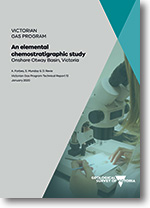VGP Technical Report 12 - An elemental chemostratigraphic study, Onshore Otway Basin, Victoria
 |
| |||||
Product description:About the Victorian Gas Program: The Victorian Gas Program (VGP) is a comprehensive science-led program, incorporating geoscientific and environmental research to assess the risks, benefits and impacts of potential onshore conventional gas exploration and production. The program is also investigating the potential for further discoveries of onshore conventional and offshore gas in the Otway and Gippsland geological basins and assessing the feasibility of additional onshore underground gas storage in depleted reservoirs around the Port Campbell area. The VGP includes an extensive, proactive and phased community and stakeholder engagement program, through which the results of the scientific studies are being communicated. Executive summary: A major elemental chemostratigraphic study of Victoria’s onshore Otway Basin was undertaken as part of the Victorian Gas Program (VGP). As part of the VGP geoscience program, the Geological Survey of Victoria (GSV) is studying petroleum systems components (reservoir, seal and source) to assess the petroleum prospectivity of the Victorian Otway Basin and estimate the potential for further onshore and offshore discoveries within Victoria’s jurisdiction. Elemental chemostratigraphy is the study of rock units whereby chemical compositions are used to distinguish between geological units and to correlate rock packages across geographic locations. This report details the findings of this new and comprehensive study resulting from the elemental analysis of 4319 legacy cuttings samples from 11 wells in the Victorian onshore Otway Basin. Chemostratigraphy is a specialised technique that can uncover geochemical differences within apparently uniform rock units. This is useful when other geological datasets do not provide enough differentiation to inform a more advanced interpretation. A regional correlation of chemically defined subdivisions was constructed, enabling a greater understanding of the resolution of the basin sedimentary sequence upon which a more refined basin model can be constructed. Chemostrat Australia Pty Ltd was engaged by GSV to undertake Inductively Coupled Plasma-Optical Emission Spectrometry and Mass Spectrometry (ICP-OES and MS) analysis to complete a regional elemental chemostratigraphic study of the Victorian onshore Otway Basin. For each of the 4319 rock samples submitted to the laboratory, the abundance of 50 chemical elements was determined. These new data were then analysed and interpreted to identify chemically distinct Sequences and Packages that can be correlated between wells. Samples were selected from 11 legacy petroleum wells held at the GSV Drill Core Library in Werribee. Key sedimentary units from the Victorian Otway Basin were included in the study: these were the Casterton Formation, Pretty Hill Formation, Laira Formation, Eumeralla Formation, Waarre Formation, Flaxman Formation, Belfast Mudstone, Nullawarre Greensand, Skull Creek Mudstone, Paaratte Formation, Pebble Point Formation, Pember Mudstone, Dilwyn Formation, Mepunga Formation, Narrawaturk Marl, Clifton Formation, Gellibrand Marl, and Port Campbell Limestone. In addition, open file elemental analysis from 573 samples from four wells in the South Australian Otway Basin were included in the study (Beach Energy, 2014; 2017). The results of this chemostratigraphic study are presented in this report and the elemental data for all 4319 samples are included in Excel spreadsheets (Attachment A1). As a result of the analysis and interpretation, seven sedimentary Sequences and one basement Sequence were identified with the sedimentary sequences and further divided into 37 chemically distinct Packages based on changes in elemental ratios in the rocks. The results of this study are presented based on lithostratigraphic subdivisions where appropriate. Chemostratigraphic interpretation however has allowed correlation of units regardless of the principal lithologies present and thus updated simple lithology-based definitions of formations. The data also allow for assessment of the nature and evolution of the volcanogenic component of the basin fill, most notably of the Otway Group sediments. The findings from this study include the identification of distinctive elemental concentrations within the Casterton Formation; the division of the Crayfish Subgroup in the Victorian Penola Trough that aligns with established stratigraphy in the South Australian Penola Trough; and mineral trends within the Eumeralla Formation, with an increasing abundance of quartz upwards through the section and notable quartz-rich units occurring throughout the formation. This new elemental chemostratigraphic analysis has been used to successfully correlate Sequences and Packages across the Otway Basin, including across the Victorian and South Australian state border. Further interpretation of the data will be carried out as part of the VGP to confirm the new findings. Bibliographic reference: Forbes, A., Munday, S. & Revie, D. 2020. An elemental chemostratigraphic study, Onshore Otway Basin, Victoria. Victorian Gas Program Technical Report 12. Geological Survey of Victoria. Department of Jobs, Precincts and Regions. Melbourne, Victoria. Download: The downloadable version of this report is supplied in PDF format (21.2 MB), Attachment A1 (ZIP 8.7 MB) and Attachment A2 (ZIP 45.6 MB). | ||||||

